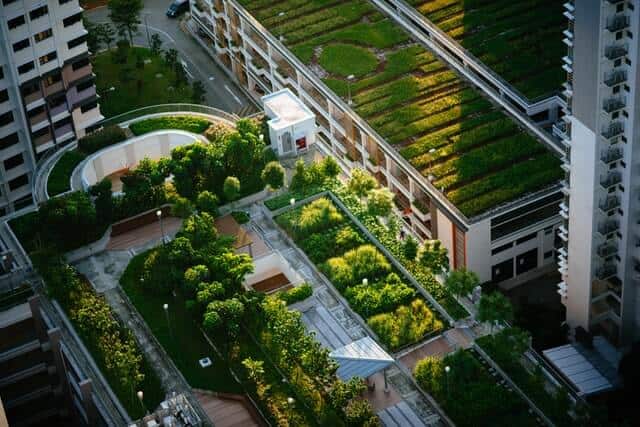I live in the city and lead a growing family. Needless to say, our space would soon grow smaller while our food and health needs get more demanding. When I think about sustaining my family in an industrialized area, I’d end up thinking about urban farming.
What is it about? How can it help sustain my needs and yours? In what ways can it benefit our health and that of the environment? How can you and I get started? What tools will we need?
Here are the questions we’ll probe as I seek to introduce you to one form of sustainable gardening.
Table of Contents
1. What Is Urban Farming?

The basic concept around urban farming is quite simple. It’s all about growing food in the city. Although the purposes, methods, and tools differ, the fundamental element is the same.
So, here’s the key point. Urban farming is simply growing food in a place that is:
- densely populated,
- usually isolated from nature, and
- highly industrialized.
If you think of the two words put together, “urban” and “farming” are almost exact opposites. But that was just the case until the innovative idea came along.
Purpose Of Urban Farming
The concept of urban farming rose to fame when the need arose in North America and Europe. It was during the period surrounding World War II. To alleviate the scarcity, growing food outside of rural areas became a necessity.
Also termed as urban agriculture, urban farming serves a lot more purpose to date. Aside from growing food only to be eaten, it now serves to grow food in the cities to:
- be sold (make profits),
- increase plant variety,
- increase animal diversity,
- bring people to work together,
- educate the people how it’s done,
- improve the community’s mental and physical health, and
- help poor neighborhoods rise.
Where Is Urban Farming Done?
The short answer is that we do urban agriculture wherever we find space in our dense neighborhood.
So, urban “farms” may not seem to be as visibly wide as rural farms. In a sense, urban farming is small space gardening. Your typical locations would be as follows:
- rooftops,
- warehouses,
- brownfields,
- backyards,
- front yards, and
- even inside your home.
Indeed, urban farming is a practical and innovative way to survive in the 21st century.
2. Benefits Of Urban Farming
Now that you have a basic understanding of urban farming, it’s time to check whether you could personally benefit from it or not.
With a quick overview, let me mention the most known advantages of urban agriculture.
By the way, I’ve also included a few links to sample urban farming systems and tools below. You might find them useful in getting started with your own urban farm.
Increased Food Security
Urban farming saves you time and money—your fundamental resources. Lesser demand for resources means greater sustainability. Increased sustainability, in turn, implies having greater food security.
Outland Living’s Raised Garden Bed
For instance, even if you don’t have so much space, you can make use of Outland Living’s Raised Garden Bed. It’s a type of vertical garden with elevated planters, and you may place this system in your patio or balcony.
One advantage of this “raised” garden bed is its cascading water drainage feature. This means you can first water your topmost plants and any excess water just drains down to each succeeding row.
As a result, you can save water—and by extension—money. You also save time in watering!
Less Insect Pressure
Housed in more controlled environments, your plants could suffer from less insect attack. That’s one advantage that I really like about urban gardening.
VIVOSUN’s Mylar Reflective Grow Tent
Consider VIVOSUN’s Mylar Reflective Grow Tent. This multi-chamber tent is tear-proof and is fully enclosed to capture almost all light in. Systems such as this can inhibit insect attack, so you can focus on enriching the plants you grow.
Open to Micromanagement
To manage stately farms in rural areas, you will need lots of workers. With backyard or indoor gardening, however, you can monitor your plants up close—even in an automated fashion.
AeroGarden’s Bounty Elite
Take, for instance, AeroGarden’s Bounty Elite. This stainless steel garden system has a touchscreen panel that reminds you when to add plant food and water.
It also allows you to grow anything without soil, adjust the grow lights, and fill up to 9 pods of different plants in one growing period. I think it’s a great tool to start an indoor vegetable garden.
Personal Health Benefits
With a garden that you can micromanage, fresh and healthy produce can become readily available on your plate.
GrowLED’s Plant Grow Light
Consider GrowLED’s Plant Grow Light. It’s a minimalist growing system for plants, powered with auto-timed LED lights for indoor gardening. If you plant leafy vegetables and herbs in it, you can literally pick your next meal from this “mini garden.”
GrowLED’s Kitchen Garden promotes photosynthesis in plants. It mimics natural plant growth even if you place the system in an area with very little sun exposure. So, if you want to eat herbs without the pesticides, you may grow and closely monitor your food using this system.
Environmental Preservation
Current technologies involved in urban farming require little to no use of soil. Thus, you don’t need to occupy vast lands for farming. Urban agriculture helps you to:
- use land efficiently,
- consume less water, and
- produce less waste.
In the sample products above, I’ve shown you how urban farming can give you such environmental benefits.
If you wish to start urban gardening on a personal level, you may want to begin with the growing systems I’ve mentioned. Here’s a quick recap before we head on to the next section.
- Outland Living’s 4-Ft Raised Garden Bed
- VIVOSUN’s Mylar Reflective Grow Tent
- AeroGarden’s Bounty Elite with Gourmet Herb Seed Pod Kit
- GrowLED’s Plant Grow Light/LED Indoor Garden Light
3. Ways To Do Urban Farming
So, how do you do urban farming in the broader sense? I’ve only mentioned a few examples of how you can grow food in an urban setting—but it was quite limited to a personal level. What if you want to expand and actually profit from your garden produce?
Well, let me discuss the most beneficial methods.
Hydroponics
The basic definition of hydroponics is growing plants in water—without the use of soil.
Yeah, it sounds untraditional, but the practice actually started a long time ago. Here’s a short video to explain it further.
As explained, you can enjoy increased yields when using hydroponic systems. If you take advantage of this urban farming method, you may easily translate it to profits.
So, if you think you’re inclined to doing hydroponics, here is a system that I could personally recommend.
DreamJoy Hydroponic Grow Kit
This hydroponic grow kit is quite suitable for beginners. You don’t have to be trained to use this system.
Aquaponics
Are in you into organic gardening? If so, aquaponics is something you might love doing.
To put it simply, all kinds of aquaponics belong to hydroponics, but not vice versa. In other words, aquaponics is just a subset of hydroponics.
By definition, aquaponics combines aquaculture and the general concept of hydroponics. While aquaculture is about raising fish, aquaponics reuses fish produce waste to fertilize plants. The plants, in turn, filter water before it returns to the fish.
So, if you’re into sustainable gardening, you should probably consider doing aquaponics. Below is a product that I think will help you start small.
Springworks Microfarm Aquaponic Garden
While you may think of aquaponics as some large scale system, you can actually begin with a “micro-farm” such as this.
The Springworks Microfarm Aquaponic Garden is a home aquaponics system that goes well with a standard 10-gallon aquarium. This product can be a great start if you love growing both plants and fish.
I’ve tried setting up a system such as this at home. My kids just loved feeding the fish all the more! And I think it’s a fun way to start gardening with kids!
Vertical Farming
Vertical farming is a rather general term. In fact, it can include hydroponics, aquaponics, aeroponics, and several other innovative methods—depending on the set-up.
For a growing system to be considered a form of vertical farming, the requirement is simple. You maximize vertical space, stacking plant rows instead of spreading them across a vast, horizontal land area.
To get started with a vertical farm, you may want to try the following product.
Altifarm All Seasons Home Farm
While it can be used outdoor, this growing system by Altifarm includes a pack of grow lights for indoor use. It also boasts of a self-watering system. This means you only need to water the system every 7 to 10 days—and that spells convenience.
4. Start Your Mini Urban Farm
You may want to start your own urban farm either for your personal or commercial use. Either way, great benefits await you.
So, to help you get started, let me outline a few points before I end this urban farming guide for beginners.
Pick A Spot
If you have free space outside of your home, you’re a lucky urban dweller. While I haven’t referred to traditional backyard gardening above, I still recommend it. It’s actually a good place to start.
On the other hand, if you’re staying in an apartment, you can always do indoor gardening. I’ve already given you a few product recommendations for you to start with.
Know What You’re Planting
If you know your purpose, it’s likely that you already have a plant to grow in mind. If so, pick the best planter or urban gardening system for that plant. Of course, you have to consider your space—the one you’ve thought about in the previous point.
Get Licensed To Sell
If you’re doing urban farming for business, be sure to cover your legal grounds. Also, educate yourself further as you transition from personal to commercial urban agriculture.
As a final note, let me leave you with this informative resource on commercializing an urban farm.
Summary
Urban farming is indeed a profitable and innovative solution for meeting the demand for sustainable food production in the cities. Getting started isn’t that difficult either. As with any new venture, you can simply start small.
Depending on your current space and resources, you may do indoor gardening, vertical farming, hydroponics, or aquaponics, among others. Finally, remember that while you can grow food for personal consumption, you may also commercialize your produce.







